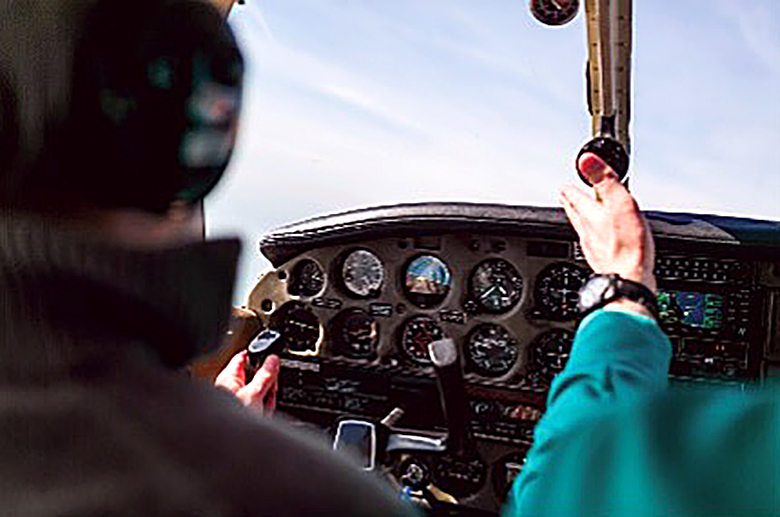Mistakes Happen
How the FAA’s Compliance Program Promotes Accountability for All Pilots
By Jeffrey Smith, FAA Flight Standards Safety and Compliance Team

“Mistakes happen.” Certainly not a profound statement and there are plenty of affirmations that can be found about mistakes, how to recover from them, and how to learn from them. One that I particularly like is, “Mistakes have the power to turn you into something better than you were before.” Seems like great advice for life overall! But what about when mistakes happen in aviation? Do we view them from the same perspective as we do for mistakes in other areas? How should we react to them? And, of course, how does the FAA treat mistakes committed by student pilots and instructors?
Despite all of the encouraging phrases about mistakes, people generally strive to not commit them in the first place. This reminds me of another quote: “An ounce of prevention is worth a pound of cure.” This is very true in aviation where even simple errors can have disastrous and deadly consequences. So how do you and I prevent mistakes from occurring in the first place? Well, the regulations are a good place to start as a minimum baseline for safety standards. From the general aviation pilot’s perspective, Title 14 Code of Federal Regulations, Title 14 (14 CFR), parts 61 and 91 contain a wide range of requirements intended to support safe operations in the National Airspace System (NAS). And while regulations present the minimum requirements, our obligation as good and safe pilots also includes looking at risk that extends beyond the regulations.
Our obligation as good and safe pilots includes looking at risk that extends beyond the regulations.
For example, it is critical to maintain knowledge of the aircraft you are operating to include limitations, V-speeds, system operations, and emergency procedures. Do you have a way to ensure familiarity when you fly in a different aircraft? Knowledge of the airports you intend to operate at is also critical, as is weather and enroute airspace. External pressure to arrive at the destination by a certain time can influence our willingness to accept risk. And this brings us to another applicable quote, “know thyself.” Your mental and physical state should certainly be a factor in your go/no-go decision-making. Further, the baseline regulatory limitations may not be enough for you given your current experience and proficiency level.

So how do we take the above and turn it into action that helps prevent mistakes? As pilots, we should be executing repeatable processes for every flight. Using a checklist is probably the most basic and familiar way to do this. Checklists provide items to inspect and actions to perform during all phases of flight. But do you have a checklist or other method that covers all applicable preflight preparation items? This can include checking past, current, and forecast weather, ensuring acceptable weight and balance, reviewing NOTAMs and TFRs, offering proper passenger briefings, and confirming you have your necessary documents (e.g., pilot certificate, medical certificate, and photo identification). Incorporating the PAVE and IMSAFE acronyms into your preflight routine can also be beneficial. When it comes to personal minimums, do you review those before each flight and update them as needed? Further, do you have a post-flight assessment process that has you challenge yourself on how you could improve before the next flight?
To help prevent mistakes, pilots should be executing repeatable processes for every flight, like using a checklist.
We need consistent and systematic methods of ensuring safety as noted above (e.g., checklists, personal minimums, etc.). Maintaining safety should not be based on luck. If luck is your strategy, you may want to examine that before — as the saying goes — “your luck runs out.” But sometimes, despite our best efforts, mistakes do in fact happen. So how should we react?

First, we must address any immediate safety concerns. These concerns can be wide-ranging and, at the extreme end, involve an in-flight emergency. This is not the time to dwell on how the situation came to be or the potential reaction from your pilot peers or the FAA. For instance, if you’re running low on fuel, please do not waste critical time wondering if you erred in your preflight calculations, if your instructor will be disappointed, or if your certificate will be in jeopardy. Rather, focus on finding a nearby alternate landing location. Remember, ATC can be a real lifesaver in this situation. As a good practice, you should have the contact frequencies for your areas of flight or at least know how to quickly determine those frequencies from your electronic or paper-based navigation products. In all cases, your main focus should be on addressing the emergency and landing safely.
Other in-flight concerns may not be life-threatening but can necessitate immediate action. Realizing you have flown into controlled airspace without a clearance is a good example. Take steps to exit the airspace, if able, and attempt to communicate with ATC. Trying to evade detection will only increase the immediate safety risk and will ultimately result in a strong reaction from the FAA.
Finally, some situations involve simply ceasing the operation until the safety issue or noncompliance can be corrected. For example, you have planned a flight on the first day of the month only to realize your aircraft’s previous annual inspection expired the day before. Please do not take the flight with the mindset that one day doesn’t matter. Even if the flight is conducted without a negative outcome, committing one intentional violation of the regulations can lead to routine noncompliance. This ultimately results in a degraded safety posture until, as noted above, “your luck runs out.” And, as we’ll explain later, intentional acts, regardless of the outcome of the flight, will result in strong reactions from the FAA.
Okay, so how does the FAA handle deviations from the regulations? As part of its oversight model, the FAA has developed the Compliance Program. The Compliance Program has, at its foundation, an appreciation for transparency and an expected willingness/ability to prevent reoccurrence of the noncompliance. Deviations resulting from flawed procedures, simple mistakes, lack of understanding, or diminished skills may be addressed with compliance actions. Compliance actions are non-enforcement and include an on-the-spot correction, counseling, or additional training and education. So that example of running low on fuel, even if you did not take off with the required amount per 14 CFR section 91.151, could be resolved outside of enforcement.
Download the Compliance Program Brochure here.
 In all cases, the intent is to address the root cause of the issue to preclude it from happening again. There may be additional follow-up performed on the part of the FAA to validate the corrective actions were effective. This brings us to what the Compliance Program is not: a “get out of jail free” card. Rather, the intent is to use the most effective means to address safety concerns. This can even include corrective action taken by you prior to being contacted by the FAA following a regulatory noncompliance, such as receiving ground or flight instruction in the relevant subject areas.
In all cases, the intent is to address the root cause of the issue to preclude it from happening again. There may be additional follow-up performed on the part of the FAA to validate the corrective actions were effective. This brings us to what the Compliance Program is not: a “get out of jail free” card. Rather, the intent is to use the most effective means to address safety concerns. This can even include corrective action taken by you prior to being contacted by the FAA following a regulatory noncompliance, such as receiving ground or flight instruction in the relevant subject areas.
Sometimes, however, the most effective means to restore safety in the NAS is through the use of legal enforcement actions. These include certificate suspensions, revocations, or monetary penalties. These actions will be taken in cases where repeated noncompliance indicates the person is either unable or unwilling to remain in compliance. Also, intentional, reckless, or criminal acts, as well as failure to complete agreed-upon corrective actions, are also grounds for the FAA to take legal enforcement action. Administrative actions (e.g., warning letter) may also be used when appropriate to formally convey and document a regulatory deviation.
Additional information regarding the Compliance Program can be found in the Learn More Section below.
While we should be taking steps to prevent safety deviations, as long as humans are involved, mistakes will occur. But rather than attempt to ignore, dismiss, or even hide the error, we should address it head-on. First, let’s resolve the immediate safety concern and cease any ongoing non-compliance. Then, let’s take action to prevent future reoccurrence, such as adding items to a checklist or receiving additional flight instruction.
Convention holds that we appear flawless as pilots, and we should be confident and capable in any operation we conduct. However, we should also strive toward a culture that appreciates those who hold themselves accountable and are willing to take meaningful corrective actions. This type of conduct will continue to elevate safety within the NAS. As the next generation of pilots (or those teaching and mentoring them), you can, and should, always be seeking to be “… better than you were before.”
Learn More
Jeffrey Smith is the manager of the FAA’s Flight Standards Safety and Compliance Team. He holds an ATP certificate, is a flight and ground instructor, and an A&P mechanic.
Reprinted with permission from FAA Safety Briefing. Visit the Flight Safety Briefing website: https://www.faa.gov/news/safety_briefing/.



